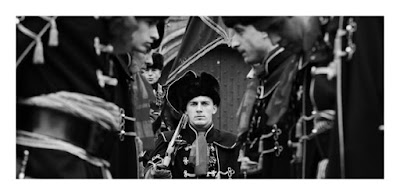
The neck tie is a piece
of clothing/ fabric worn majorly by men all around the world, Have you wondered
how the neck tie came to be? It may interest you to know that the trend of
putting on neck ties dates as far back as the 16th century. You would agree with me that this piece of fabric
around the neck doesn’t keep you any warm neither does it add any comfort, but
a lot of people love the neck tie myself included, so how did the necktie come
about? My curiosities lead me to discover
the amazing story behind the neck tie.

A 30 year war in France
saw a fearless and ruthless group from Croatia highly regarded as the very best
soldiers pay visit to Paris. In 1660 in celebration of its victory over the Ottoman
Empire
King Louis XIV invited his hired Croatian mercenaries to Paris, this
crack regiment from the Croatian military turned out in Paris in an impressive
piece of cloth around their neck as part of their uniform. They wore brightly
colored handkerchief of silk around their necks (see picture above).
However this left an
effect on the boy King, who was impressed by this piece of clothing on the
necks of the soldiers presented to him as ‘glorious heroes’ of the war. These
neck cloths struck the kings fancy, and he soon made them an ‘insignia’ of
royalty as he created a regiment of Royal Cravattes. He also made these ties a
mandatory wear for royal gatherings. To honor the Croatian soldiers he gave
this clothing piece the name “La Cravate” derived from the à la croate
meaning in the style of the Croats. The word "cravat" is the name for
necktie in French to this day.

The boy-king Louis XIV began wearing a lace cravat
about 1646, at seven, and set the fashion for French nobility. However this new
clothing accessory started a fashion craze in Europe; with both men and women
wearing pieces of fabric around their necks. From its introduction by the
French king, men wore lace cravats that took a large amount of time and effort
to arrange, tied in place by cravat strings, arranged neatly and tied in a bow.
The immense skill required to tie the cravat in certain styles, quickly became
a mark of a man's elegance and wealth.
Another kind of neck-wear, called
"stocks" made its appearance gaining popularity in the 17th
century. The term originally referred to a leather collar, laced at the back,
worn by soldiers to promote holding the head high in a military bearing. Their
popularity eclipsed the white cravat, except for formal and evening wear. But
by 1850s another form of neck-wear worn was the scarf. In this case a
neckerchief was held in place by slipping the ends through a finger or scarf
ring at the neck instead of using a knot. Then sailor neck wear style and may
have been adopted from them. Again around this time the "pre-tied",
also know as the clip-on necktie is (i.e. bow tie affixed by clip or hook, to
the shirt front without the aid of a band around the neck) made appearance.
The four-in-hand necktie became popular in Great Britain in the 1850s. At this time, there was much interest in the way to tie a proper cravat and this led to a series of publications. The book Neckclothitania was the first book which contained instructions and illustrations on how to tie 14 different cravats.
By 19th century a seven fold tie made its appearance, its origination is attributed to Parisian shirt maker Washington Tremlett for an American customer. Latter a six-fold tie became the modern alteration of the seven-fold tie.

With
the spread of the industrial revolution people wanted neckwear that was easy to
put on, comfortable, and would last an entire workday. Neckties were designed
long, thin and easy to knot, and they did not come undone. This necktie design
is still worn by millions of men today.
The fifties are most famous for the
emergence of the skinny tie; a necktie that is narrower than the standard tie
having widths of around 2 1⁄2 inches, unlike the usual 3 to 4
inches for regular ties. First popularized in the late 1950s and early 1960s by
British bands (i.e. the Beatles and the Kinks. And later re-popularized in the
70s and early 80s by bands such as the Knack, Blondie and Duran). Worth mentioning
is the ultra wide “Kipper Tie” which was
embraced by the disco movement of the 70s. The creation of the Bolo Tie (aka Western Tie) in 71 became
Arizona’s official state neckwear.
Today, ties expresses a modern mans personal style, we
have them available in many widths, cuts, fabrics, and patterns. International
Necktie Day is celebrated on October 18 in Croatia and in various cities around
the world.


No comments:
Post a Comment